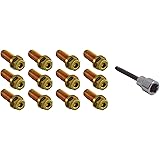===
Are you a proud owner of a 1998 Toyota Supra? If so, you may be interested in unlocking the full potential of your vehicle’s performance. One way to achieve this is by upgrading to a wideband oxygen sensor. This article will delve into the numerous benefits that come with using a wideband oxygen sensor for tuning your 1998 Toyota Supra. From improved performance to perfect air-fuel ratios, read on to discover how wideband oxygen sensors can take your Supra to new heights.
Design Engineering 010123 2" x 25' Pipe Wrap Kit with 4 Locking Ties - Titanium
$32.38 (as of 07/26/2024 05:24 GMT -07:00 - More infoProduct prices and availability are accurate as of the date/time indicated and are subject to change. Any price and availability information displayed on [relevant Amazon Site(s), as applicable] at the time of purchase will apply to the purchase of this product.)240T Thickened Automotive Glass Sunshade and Comes with Storage Bag,Keep Car Interior Cool,Universal Windshield Sun Shade Fit for Cars,Trucks,SUVs (L(57.08 * 31.5 inch))
$9.99 (as of 07/26/2024 05:24 GMT -07:00 - More infoProduct prices and availability are accurate as of the date/time indicated and are subject to change. Any price and availability information displayed on [relevant Amazon Site(s), as applicable] at the time of purchase will apply to the purchase of this product.)Spectre Performance SPE-46723 46723 7/8" Header Bolt
$13.99 (as of 07/26/2024 05:24 GMT -07:00 - More infoProduct prices and availability are accurate as of the date/time indicated and are subject to change. Any price and availability information displayed on [relevant Amazon Site(s), as applicable] at the time of purchase will apply to the purchase of this product.)Everlasting Comfort Doctor Recommended Memory Foam Seat Cushions for Office Chairs - HSA FSA Eligible Tailbone Pain Relief Cushion, Sciatica & Back Support, Office Chair Cushion & Car Seat Cushion
$26.39 (as of 07/26/2024 05:24 GMT -07:00 - More infoProduct prices and availability are accurate as of the date/time indicated and are subject to change. Any price and availability information displayed on [relevant Amazon Site(s), as applicable] at the time of purchase will apply to the purchase of this product.)Flowmaster 817477 American Thunder Cat-back Exhaust System
$828.86 (as of 07/26/2024 05:24 GMT -07:00 - More infoProduct prices and availability are accurate as of the date/time indicated and are subject to change. Any price and availability information displayed on [relevant Amazon Site(s), as applicable] at the time of purchase will apply to the purchase of this product.)Aujen Silicone Black License Plate Frames, 2 Pack Universal Car License Plate Holders, Rust-Proof and Weather-Proof Accessories (Black)
$9.90 (as of 07/26/2024 05:24 GMT -07:00 - More infoProduct prices and availability are accurate as of the date/time indicated and are subject to change. Any price and availability information displayed on [relevant Amazon Site(s), as applicable] at the time of purchase will apply to the purchase of this product.)Why Upgrade to a Wideband Oxygen Sensor for 1998 Toyota Supra?
If you’re wondering why it’s worth upgrading to a wideband oxygen sensor for your 1998 Toyota Supra, the answer lies in the advanced technology and accuracy it offers. Unlike the factory oxygen sensor, a wideband sensor provides a much wider range of readings, allowing for more precise tuning. This means you can achieve optimal performance and maximize the potential of your Supra’s engine.
Unlock the Potential: Benefits of Wideband Oxygen Sensor Tuning
The advantages of wideband oxygen sensor tuning for your 1998 Toyota Supra are vast. Firstly, it allows you to fine-tune your engine’s air-fuel mixture to achieve the perfect balance. This not only enhances power output but also improves fuel efficiency. Additionally, wideband oxygen sensor tuning can help prolong the life of your engine by preventing it from running too lean or too rich.
Improved Performance: How Wideband Oxygen Sensors Boost Supra Tuning
By using a wideband oxygen sensor for tuning your 1998 Toyota Supra, you can significantly enhance its performance. With accurate feedback on the air-fuel ratio, you can precisely adjust your engine’s fuel delivery and ignition timing. This results in improved throttle response, smoother acceleration, and increased power throughout the entire RPM range. Whether you’re on the street or the track, wideband oxygen sensor tuning will undoubtedly take your Supra’s performance to the next level.
Perfect Air-Fuel Ratios: Advantages of Wideband Oxygen Sensors
Achieving the perfect air-fuel ratios is essential for optimal engine performance. Wideband oxygen sensors excel in this area by providing a detailed and accurate measurement of the air-fuel mixture. With this information, you can adjust the fuel injection and ignition timing to ensure the engine is running at its peak efficiency. This not only boosts power output but also reduces emissions, making your Supra more environmentally friendly.
Smoother Power Delivery: Tuning the 1998 Toyota Supra with Wideband Oxygen Sensors
One of the key benefits of tuning your 1998 Toyota Supra with wideband oxygen sensors is the smoother power delivery it offers. With precise control over the air-fuel mixture, you can eliminate any hesitation or flat spots that may occur during acceleration. This results in a seamless power delivery, allowing you to fully exploit the capabilities of your Supra and enjoy a thrilling driving experience.
Fine-tune Your Supra: Enhance Performance with Wideband Oxygen Sensor Tuning
In conclusion, upgrading to a wideband oxygen sensor for tuning your 1998 Toyota Supra comes with a plethora of benefits. From unlocking the engine’s full potential and improving performance to achieving perfect air-fuel ratios and enjoying smoother power delivery, wideband oxygen sensor tuning is a game-changer. So, if you’re looking to take your Supra to new heights and unleash its true performance, it’s time to invest in a wideband oxygen sensor and experience the difference it can make. Your Supra deserves nothing less than the best!





